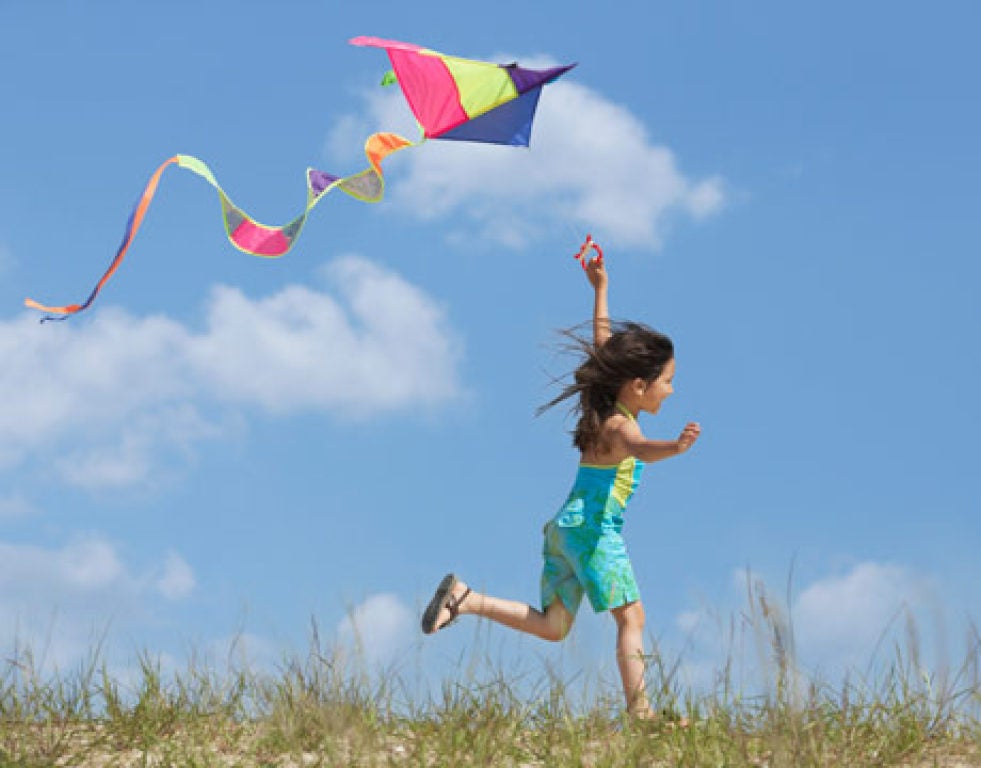April is National Kite Month, May 12 is Kite Day, and June 15 is Fly a Kite Day. February 8 – which seems a shivery time for it – is Kite Flying Day. In Japan, the Hamamatsu Festival, during which giant kites are flown, is held in early May. Kites, however, are fun (and educational) just about anytime. Provided you’ve got a little wind.
See below for kite stories, scientific kites, mathematical kites, easy-to-fly kites, kite poems, a kite princess, and kites at war. And more.
Table of Contents
JUST FOR STARTS…
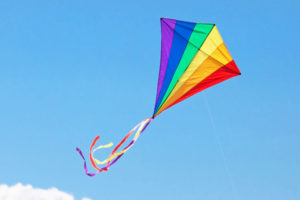 |
National Kite Month has many suggestions for celebrating – how about building a kite or writing a kite haiku? Or take the challenge: fly a kite every day for 30 days. |
| From the American Kitefliers Association, see Explore the World of Kites for information on kite science and history, kite activities, instructions for making kites, and much more. | |
| The Drachen Foundation has information about all things kite, including kite history, culture, and science, kite plans for kite builders, kite events, many creative kite lesson plans (categorized by grade level from K-8), and an online store which sells kite kits (for all ages), books, and supplies. | |
 |
Best Breezes is a website dedicated to the history, science, and art of kites. Included are information on the science of kite flight, kite history timelines, and biographies of kite pioneers, among them William Eddy, Guglielmo Marconi, and Alexander Graham Bell. Click on Kites as Art for a terrific 20-page illustrated booklet, Art Kites, in pdf format, which covers the science, history, and art of kites. (Check out the Vietnamese peacock kite.) |
KITE TALES

|
In Vera B. Williams’s Lucky Song (Greenwillow Books, 1997), Evie’s grandpa builds her a kite and off she goes for a blue-sky, kite-flying day – all of which is the subject of the lucky song that her father sings for her at the end of the book. For ages 3-5. |
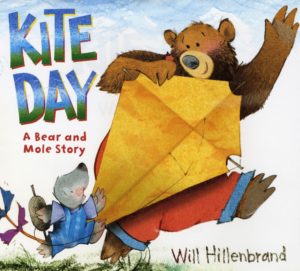
|
In Will Hillebrand’s Kite Day (Holiday House, 2012), Bear and Mole build a kite and send it soaring into the sky, only to lose it when the string snaps in a storm. It ends up lodged in a tree, sheltering a nest of baby birds. An adorable read for ages 3-5. |
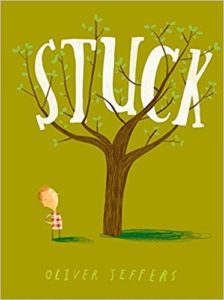
|
In Oliver Jeffers’s Stuck (Philomel, 2011), Floyd has a lot in common with Charlie Brown: his kite is hopelessly stuck in a tree. He tosses up a shoe to knock it free, and the shoe sticks too – then the other shoe, and soon a host of improbable objects, including a bucket of paint, the milkman, a truck, a ladder, a whale (who happened to be “in the wrong place at the wrong time”), and, inevitably, the kitchen sink. Hilarious, for ages 3-7. Cheering for all with stuck kites. |
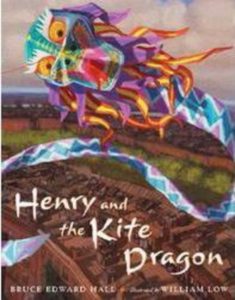
|
In Bruce Edward Hall’s Henry and the Kite Dragon (Philomel, 2004), eight-year-old Henry lives in New York City’s Chinatown and loves flying kites with an elderly neighbor, a kitemaker. When some boys from nearby Little Italy start throwing rocks and destroying the kites, it looks like war – until Henry discovers the problem: the kites are frightening the boys’ pet pigeons. The book ends with compromise and a new friendship. For ages 4-7. |
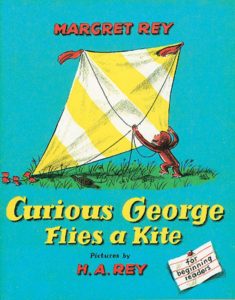
|
In Margaret and H.A. Rey’s Curious George Flies a Kite (Harcourt, 1977), George’s curiosity – despite warnings from the Man in the Yellow Hat – leads him into all sorts of trouble, including being yanked up into the sky by a kite. (The Man in the Yellow Hat rescues him with a helicopter.) For ages 4-7. |
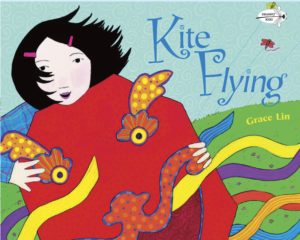
|
In Grace Lin’s Kite Flying (Dragonfly Books, 2004), a Chinese family – parents and two daughters – buy supplies, build a dragon kite, and head outdoors to take it for a flight. For ages 4-7. |
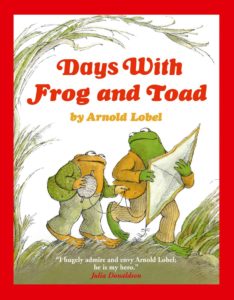
|
Among the funny and delightful stories in Arnold Lobel’s Days with Frog and Toad (HarperCollins, 1984) – starring the patient and optimistic Frog and the impatient and pessimistic Toad – is “The Kite,” in which the pair repeatedly fail to launch a kite. (Try shouting UP KITE UP, Frog suggests.) For ages 4-8. |
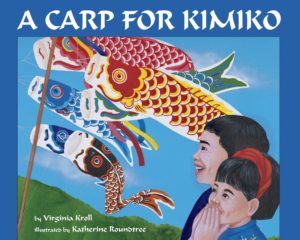
|
In Virginia L. Kroll’s A Carp for Kimiko (Charlesbridge Publishing, 1994), Kimiko knows that every Children’s Day in Japan, a wonderful carp kite is flown for every boy in the family – but even so, she wishes for a carp of her own. She doesn’t get a kite, but she does get a special symbolic gift. For ages 4-8. |

|
In Jane Yolen’s The Emperor and the Kite (Puffin, 1998), the little princess Djeow Seow is ignored by everyone and spends her time alone, playing with her kite. When her father, the king, is taken hostage by kidnappers, however, it’s the clever princess with the kite who manages to rescue him. The illustrations are wonderful Chinese-style paper-cuts by Ed Young. For ages 4-8. |
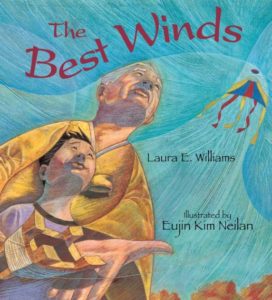
|
In Laura Williams’s The Best Winds (Boyds Mills Press, 2006), Jinho’s old-fashioned Korean grandfather still practices the ancient craft of kite-making, and insists on showing Jinho how to make a kite, in preparation for the coming of “the best winds.” Jinho, impatient, takes it out prematurely, wrecks it, and then – when he realizes his grandfather’s disappointment – stays up all night repairing the damage. The book ends with grandfather and grandson sharing a bond and a kite. For ages 4-8. |
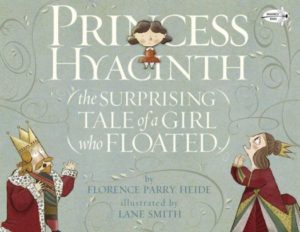
|
In Florence Parry Heide’s Princess Hyacinth (Schwartz & Wade, 2009), Hyacinth, to the dismay of her royal parents, floats – unless firmly and miserably weighted down with diamond pebbles in her socks and an enormous crown with a chinstrap. One day Hyacinth meets a balloon man and, entranced, decides to try floating while clutching a balloon. Instead she nearly vanishes into the sky, only to be rescued by a boy with a kite – whom she’s always admired from afar. The story ends happily, with the pair the best of friends, the princess floating to her heart’s content, and popcorn in the palace garden. For ages 4-8. |
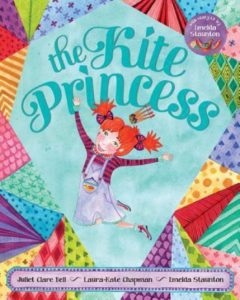
|
In Juliet Clare Bell’s The Kite Princess (Barefoot Books, 2012), tomboy Princess Cinnamon Stitch runs off to the woods in overalls and ends up with a scold, told sternly that princesses can only sing and sew. Undeterred, Cinnamon stitches up a glorious multicolored kite and soars singing into the sky. For ages 5-8. |
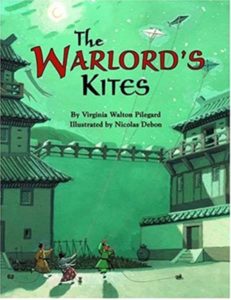
|
Virginia Pilegard’s The Warlord’s Kites (Pelican Publishing, 2004) is one of a series set in ancient China. starring Chuan, an artist’s apprentice with a knack for math. In this book, Chuan and friend Jing-Jing manage to frighten away an enemy army by building kites with flutes tied to their tails. For ages 5-8. |
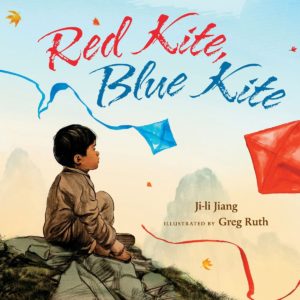
|
In Ji-li Jiang’s Red Kite, Blue Kite (Hyperion Books for Children, 2013), Tai Shan and his father love to fly kites together – one red, one blue – from their city rooftop. Then the Cultural Revolution comes to China, chaos reigns, and Tai Shan goes to live with his grandmother after his father is sent away. Still, each day father and son maintain their bond by flying kites – one red, one blue – while waiting for freedom and the father’s return. For ages 5-8. |
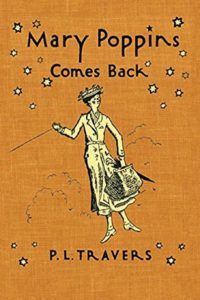
|
In the second book of the Mary Poppins series, P.L. Travers’s Mary Poppins Comes Back (Harcourt, 2006), everyone’s favorite nanny returns to 17 Cherry Tree Lane by kite. For ages 7 and up. |
| The 1964 Walt Disney film version of Mary Poppins ends with a kite-flying expedition and the song Let’s Go Fly a Kite. | |
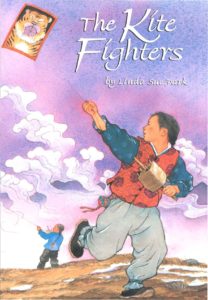
|
In Linda Sue Park’s The Kite Fighters (Sandpiper, 2010), set in 15th-century Korea, two brothers – both passionate about kites – attract the attention of the king as they prepare to participate in the annual New Year’s kite-fighting competition. Traditionally, the oldest son in the family flies the competition kite, but in this case the younger is by far the better kite flier. For ages 8-12. |
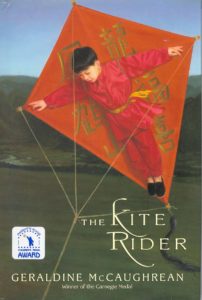
|
Geraldine McCaughrean’s The Kite Rider (HarperTeen, 2003) is set in 13th-century China, where 12-year-old Haoyou witnesses the death of his father, engineered by the man who wants to marry Haoyou’s beautiful mother. With the help of his clever cousin Mipeng, Haoyou sets out to rescue his mother. He ends up joining the Jade Circus as a kite rider, where he soars into the sky strapped to a red-and-gold kite, and performs at the court Kublai Khan. An exciting story for ages 11 and up. |
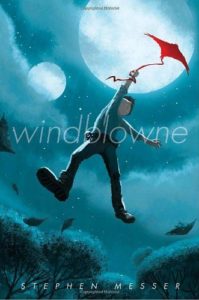
|
Stephen Messer’s Windblowne (Random House, 2010) is a fantasy world with two moons, in which people live in oak trees and are passionate about the annual midsummer kite festival. Oliver, our hero, is a klutz with kites, so he goes for help to his great-uncle Gilbert, a former kite champion – only to see Gilbert disappear after an attack by ferocious kite creatures. With the help of one red kite that Gilbert has left behind, Oliver sets out on a quest through many alternate Windblownes, populated with alternate Gilberts and Olivers. Adventure with an ecological message for ages 12 and up. |
